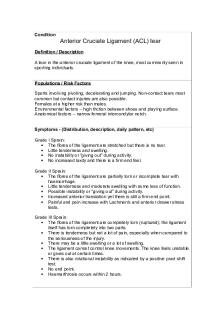Case study Rotator cuff tear PDF

| Title | Case study Rotator cuff tear |
|---|---|
| Course | Physical Therapy |
| Institution | University of the East Ramon Magsaysay |
| Pages | 3 |
| File Size | 66.6 KB |
| File Type | |
| Total Downloads | 17 |
| Total Views | 182 |
Summary
Download Case study Rotator cuff tear PDF
Description
Adrianna Parra Clinical Experience II Case Study #3 December 10, 2010 Rotator Cuff Tear
Adrianna Parra December 10, 2010 Clinical Experience II Case study #3 Rotator Cuff Tear To begin, a rotator cuff is made up of four muscles that help move and stabilize the shoulder joint (Emedicinehealth, 2010). Any damage to any one of the four muscles, Supraspinatus, Infraspinatus, Teres Minor, Subscapularis, or their ligaments can occur because of an acute injury, chronic overuse, or gradual aging. There are a variety of issues that arise if the rotator cuff is damaged: pain and spasm limiting shoulder range of motion, fluid accumulation with in the joint do to inflammation, arthritis and calcium deposits that form over time limiting range of motion, and muscles not able to make the small adjustments within the joint to allow the humeral head to move smoothly (Emedicinehealth, 2010). Rotator Cuff injuries are classified into 3 grades; Grade 1 strains involve stretching of the fibers without any tears, Grade 2 injuries involve partial muscle or tendon tearing, and Grade 3 injuries are defined as a complete tear of a muscle or tendon (Emedicinehealth, 2010). According to Emedicinehealth some symptoms that may accompany a rotator cuff tear are; severe pain, inability to abduct the arm or life above head, gradual onset of weakness, and point tenderness. An MRI arthrogram is usually ordered to be sure an apparent tear is there and needs fixing. After surgery simple rest and ice are the first treatment that is necessary. A sling and anti-inflammatory medication may also be helpful to help decrease pain (Emedicinehealth, 2010).
Emedicinehealth,. (2010). Rotator cuff injury . Retrieved from h t t p : / /w w w. e m e d i c i n e h e a l t h . c o m / r o ta t o r _ c u ff _ i n j u r y /a r t i c l e _ e m .h t m S.O.A.P NOTES Subjective: A Lakeview high school student came in complaining of the inability to lift his left arm past 90 degrees of range of motion in either direction. He is a defensive lineman on the football team and repeatedly goes to block the opposing team placing stress on his shoulder. He has point tenderness on the posterior side of his left shoulder. Objective: He is guarding the shoulder, being careful not to move it to an uncomfortable position. Assessment: First testing range of motion in all planes, he has a significant lost of motion in flexion, extension, and abduction. He is not able to extend past about 80 degrees without experiencing pain. Apprehension Test was positive as was Empty Can and Gerber’s Lift Off.
Plan: To get an MRI to find out if there is a tear to the rotator cuff before the injury gets worse without treatment....
Similar Free PDFs

Case study Rotator cuff tear
- 3 Pages

KNEE-ACL-tear
- 3 Pages

Tesco-Case-Study - Case Study
- 3 Pages

SLAP Tear Surgical Treatment Options
- 11 Pages

Case 7 - Case Study
- 1 Pages

Case 9 - Case study
- 6 Pages

Case-7 - case study
- 5 Pages

Tesla Case - CASE STUDY
- 22 Pages

CASE Accenture - case study
- 3 Pages

Schizophrenia. case - case study
- 4 Pages

Meiorin case - Case Study
- 2 Pages

Case Study #6 - case
- 5 Pages

Case studies - Case study
- 25 Pages

Tyco Case - case study
- 9 Pages

Gobias Case - Case Study
- 3 Pages

UBER Case - case study
- 9 Pages
Popular Institutions
- Tinajero National High School - Annex
- Politeknik Caltex Riau
- Yokohama City University
- SGT University
- University of Al-Qadisiyah
- Divine Word College of Vigan
- Techniek College Rotterdam
- Universidade de Santiago
- Universiti Teknologi MARA Cawangan Johor Kampus Pasir Gudang
- Poltekkes Kemenkes Yogyakarta
- Baguio City National High School
- Colegio san marcos
- preparatoria uno
- Centro de Bachillerato Tecnológico Industrial y de Servicios No. 107
- Dalian Maritime University
- Quang Trung Secondary School
- Colegio Tecnológico en Informática
- Corporación Regional de Educación Superior
- Grupo CEDVA
- Dar Al Uloom University
- Centro de Estudios Preuniversitarios de la Universidad Nacional de Ingeniería
- 上智大学
- Aakash International School, Nuna Majara
- San Felipe Neri Catholic School
- Kang Chiao International School - New Taipei City
- Misamis Occidental National High School
- Institución Educativa Escuela Normal Juan Ladrilleros
- Kolehiyo ng Pantukan
- Batanes State College
- Instituto Continental
- Sekolah Menengah Kejuruan Kesehatan Kaltara (Tarakan)
- Colegio de La Inmaculada Concepcion - Cebu